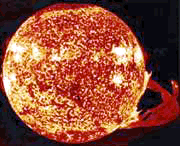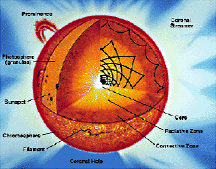AstroCappella: The Sun Song

What's it Like Inside the Sun?
An activity by Kara C. Granger
Activity Summary:
During this activity, students will examine convection in a bowl of soup. The connection is also made to convection in our atmosphere, and convection in the Sun.
Objective:
Students will perform an experiment in which they model convection as it occurs in our Sun. Students will also understand that convection acts where the effect of gravity and heat are present (low density fluids can rise and cool, and high density fluids can fall).
Materials for each group of students:
- packet or bowl of Japanese Miso (soybean paste) soup
- a dark bottomed bowl (this shows the surface effect best, use
a glass beaker or pyrex bowl to view the entire convection loop)
- access to a microwave oven, or other heating source
Engagement:
Sometimes a single physical process in nature can explain a variety of events. Convection is one such process. It functions because heated fluids (due to their lower density) rise and cooled fluids fall. A heated fluid will rise to the top of a column, radiate heat away, and then fall to be reheated, etc. Gases, like our atmosphere, are fluids too. A packet of fluid can become trapped in this cycle. When it does, it becomes part of a convection cell.
Convection also occurs on the Sun. A high resolution white light image of the Sun shows a pattern that looks something like rice grains. Very large convection cells cause this granulation (see the first illustration in this activity plan). The bright center of each cell is the top of a rising column of hot gas. The dark edges of each grain are the cooled gas beginning its descent to be reheated. These granules are the size of Earth and larger. They constantly evolve and change. Helioseismology data from SOHO allows us to map these motions underneath the Sun's surface (see the illustration below).

To explain further, this graphic shows the calculated velocity and temperature below the surface. These measurements give us the first clear picture of convection immediately below the surface of a star - possible only because the SOHO spacecraft, free of the distortions of Earth's atmosphere and the interruptions of night, is able to extend our measurements of the Sun's surface motions to scales rarely obtainable from Earth.
But these are large-scale examples of convection, and fortunately, there are examples of convection that can be modeled in the classroom. An excellent example can be seen in hot Japanese Miso (soybean paste) soup.
Procedure:
- Heat your soup according to the directions, and the instructions of
your teacher.
Be careful, it will be very hot!
- Keep in mind that the interior of the broth is hot, but the surface
of the soup is exposed to cool air. Hot `cells' of fluid rise out of the
interior of the soup to the surface, where they give off heat. Now cooled,
they fall down into the bowl to be reheated. This is one of the ways the soup
disperses its heat, and will reach room temperature.
Through conduction with the sides of the bowl, the soup will also dissipate its heat!
- Watch the granules in your soup. Do you see the rising and
descending columns of fluid? What is happening with the cells?
The soybean paste granules and other ingredients should imitate the convection cells vividly. The cells will evolve and change their positions. If the soup is stirred up students can observe the cells reform. Of course, the demonstration material can be consumed at the conclusion of the lab.
- Have you ever observed convection within our atmosphere? Think about
the cumulonimbus clouds or thunderheads in the sky that seem to evolve over a
few minutes. Explain how the process of convection could be causing the
changes.
The moisture in this cloud condenses as it cools. The air in this cloud gives up some of its heat to the cold high altitude air, and begins to fall. Next, this cell of air falls to warmer low altitudes where it can be caught up in the rising column of air. This fountain-like cell can form hail. This happens when water droplets (carried by the strong up-drafts) freeze and fall through the cloud, and are caught in the up-draft again. An additional layer of water freezes around the ice ball each time it makes a trip up through the cloud. Eventually the hail becomes too heavy to be carried up anymore, and falls out and to the ground. Large hailstones, when cut apart, actually show multiple layers, indicating the number of vertical trips the stone made while it was caught in the convection cell!
Extensions or Further Discussion:
- Discuss the major features of the Sun as illustrated in this image
below. Point out that the Sun actually consists of mostly hydrogen. Research
what other elements are present in the Sun.
- In diameter, it is over 100 times bigger than the Earth. How many Earths
could fit inside the Sun? How many Moons? How many Jupiters?

- Discuss what the difference is between conduction and convection. For the
following, indicate if the situation (mainly) involves conduction or
convection.
-
a. a boiled pot of water (with its lid on) that has been removed from the
stove.
- Convection - Heat transfer through openings such as cracks, gaps, or where pockets of heated air can escape and become cooled.
- Conduction - Heat transfer through materials such as a bowl, cup or wall.
b. a bag of freshly popped popcorn that is now opened, and has been removed from the microwave.
c. the effect of a heater in the car (in the winter) once it is warmed up and blowing into the interior.
- Imagine that you are vacationing at the beach, and you want to predict
the wind direction during the day and night. What do you predict? (Hint:
Convective currents move air away from hot areas).
References:
The graphics and other information found within this lesson can also be found on the SOHO site. The general idea for this lesson plan was adapted from a lesson in the Educator's Guide to Convection which is available from Jet Propulsion Laboratory Public Education Office Mail Stop CS-530, 4800 Oak Grove Drive, Pasadena CA 91109.
